In the heart of Mesoamerica lies an artifact that encapsulates the brilliance and sophistication of the Aztec civilization—the Aztec Skull from Tonalá, Mexico. Dating back to 600-900 AD, this extraordinary relic stands as a testament to the ingenuity and artistic prowess of its creators. Adorned with turquoise mosaic, gold eyes, and a jade ornament on the forehead, the skull transcends mere craftsmanship, embodying spiritual significance and cultural richness.

The use of turquoise, a revered stone in Mesoamerican cultures, reflects the Aztec’s deep connection with nature and the divine. The intricate mosaic work not only showcases their mastery of lapidary techniques but also symbolizes the cosmic order and the cyclical nature of life and death. Each carefully placed turquoise piece tells a story, invoking the celestial realms and the underworld, where the spirits of the deceased journeyed.
The golden eyes of the skull, gleaming with an otherworldly aura, speak of reverence for the sun god, a central figure in Aztec cosmology. Gold, the metal of the gods, symbolizes power, fertility, and divine authority. The eyes, perhaps intended to watch over the living and guide the departed souls, exude a sense of eternal vigilance and wisdom.
At the forehead rests a jade ornament, a gemstone prized for its rarity and spiritual significance. Jade held immense importance in Mesoamerican cultures, representing life, death, and rebirth. Placed prominently on the skull, this jade adornment may signify the divine essence within every being, transcending mortal existence and connecting the past with the present.

The Aztec Skull from Tonalá is more than a relic; it is a portal to a bygone era, offering glimpses into the beliefs, rituals, and artistic achievements of the Aztec civilization. It serves as a reminder of their profound understanding of the cosmos and their intricate worldview, where the earthly and the divine intertwined seamlessly.

Today, as we marvel at this exquisite artifact, we are reminded of the enduring legacy of the Aztec civilization and the richness of Mesoamerican culture. The Aztec Skull stands as a beacon of artistry, spirituality, and cultural heritage, inviting us to delve deeper into the mysteries of the past and contemplate the profound connections that bind humanity across time and space.





